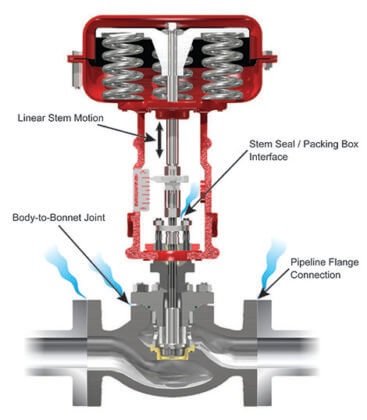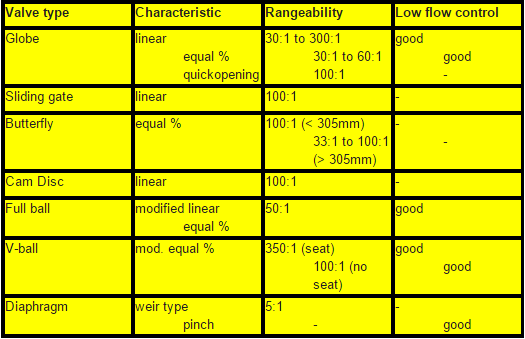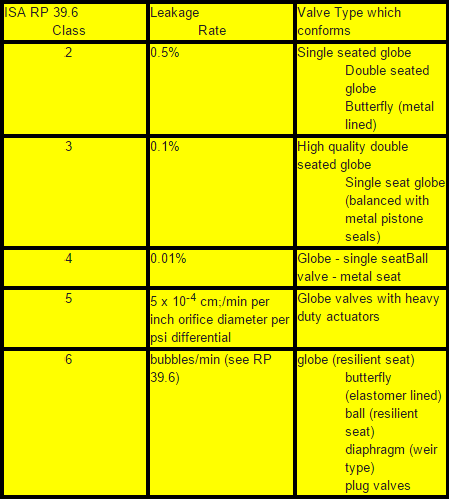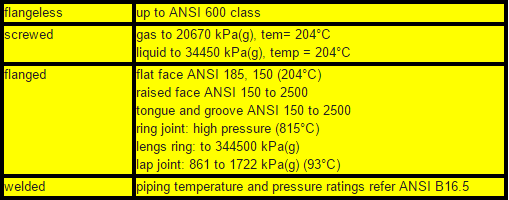Study facts about control valves include pressure drop of control valves, capacity requirements of control valves, valve rangeability, characteristics of control valves, valve body design etc.
Facts About Control Valves

Pressure Drop for Good Control
- DP = 30 to 35% of total dynamic drop for equal percentage characteristic valves
- DP = up to 50% for linear characteristics
- but > 15% adequate for most applications
- increase % DP for wide flow ranges
- decrease % DP for small flow variations
- best to optimize pumping costs with respect to valve type and DP valve
Capacity Requirements
- Design flowrate (normal flow)
- valve to control from 25 to 60% opening should be approxim. 65% of Cvrating to give control margin
- Maximum flowrates
- if not known then use 1.3-1.5 times design rate (generally 1.3)
- Minimum flowrate
- may be 3 to 4 % of rated capacity of valve
- lower flowrates clash with leakage rates of valves especially double ported types
Rangeability (Turndown)
- Assume rangeability of 15:1 to 20:1 for globe valves and 30:1 to 50:1 for ball valves
Valve Characteristics Depending on Function
- Flow control
- for wide flow range use linear characteristic
- for small flow range (but high DPV) use equal percentage characteristic
- Pressure control
- for liquids use equal percentage
- compressible fluids use equal percentage
- if < 3m of downstream pipe
- use linear characteristic if downstream system has a receiver or line > 30m length
- if pressure drop > 5:1 use equal percentage
- Liquid level control
- for constant DP use linear characteristic
- when DP decreases with load increase use linear characteristic
- if “full load DP” < 20% of no-load DP use equal percentage
- if DP increases with load increase use linear characteristic. If increase > 2:1 use quick opening type.
Flow Characteristics of Types
-
- Equal percentage
- for fast processes
- for high rangeability
- when system dynamics not well known
- at heat exchanger where product rate change demands greater change in heating or cooling to be used:
- when major portion of system DP is not available through the valve
- valve DP is high at low flows, low at high flows
- when oversizing is desirable due to limited data for past pressure control loops for most flow control loops
- Quick opening for on-off control
- when maximum valve capacity required quickly for directly connected valves such as pump governors, back pressure regulators and high capacity reducing regulators > 25 mm.
- Linear for slow processes
- when more than 40% of system DP occurs across valve
- when major process changes are a result of load changes
- when a variable head flowmeter is used
- for most level control loops
- for slow pressure control loops
- loops where measurement is linear and DP across valve is small
- 3-way valve systems
- 2-way valves in 3-way service
- Other characteristics for special applications are:
- hyperbolic
- square root
Also Read: Control Valves Terminology
Body Design (Characteristics of Types)
- Sliding gate
- reduced turbulence
- fast response
- self cleaning
- tight shutoff
- high rangeability (100:1)
- linear characteristic
- direct actuators available
- fluid must be clean
- Double port globe
- high flow capacity compared to single port
- high rangeability
- requires smaller actuator than single port (balanced design)
- reversible port
- used for > 50.8 mm size
- high leakage rates > 1%
- low pressure recovery
- erosion can occur
- no good for high flow, low DP
- Single port globe
- high rangeability
- good shut-of
- reversible plugs
- used for < 50.8 mm sizes
- unbalanced design means larger actuator
- low pressure recovery
- 3-way globe
- good for blending and diverting
- often used for temperature control of heat exchangers
- cannot control total flow
- need to know flow conditions precisely
- Split body
- good control
- tight shutoff
- simple, economic construction
- easy maintenance
- free of pockets where sediments/solids collect
- limited pressure drop due to top guiding
- Venturi angle
- good control
- high capacity, good rangeability
- tight shutoff
- minimizes erosion
- conserves space
- can handle sludges and slurries
- good for flashing
- only available > 50.8 mm
- Diaphragm
- high capacity
- low cost
- self-cleaning
- diaphragm protects working parts from fluid
- tight shutoff if pressure is low
- good for corrosive fluids
- poor control characteristics
- low rangeability
- short diaphragm life
- slow response
- not for high DP applications
- temperature limited by diaphragm material
- Butterfly
- high capacity
- economical in large sizes
- high recovery characteristic
- good for slurry services
- minimum space for installation
- available in large sizes
- operating torques are high
- tight shutoff depends on resilient seals
- throttling control limited
- Vee-ball
- high capacity
- good control, rangeability
- reasonable cost
- good for slurry services
- limited operating pressure
- no good for high DP applications
Pressure-Temperature Rating, Valve Type and CV
- Need to establish required Cv (65 to 75% rated CV), pressure and temperature rating eg. ANSI 150 class, 300 class etc.
- check valve CV limitations to establish valve types available which meet CV requirements
Shut-off Differential Pressure, Valve Type and Size
- establish maximum DP for valve, plus valve size
- check valve types available which exceed DPmax and size specifications
Throttling Differential Pressure, Erosion and Stability
- establish normal throttling DP, fluid properties (gas, liquid, abrasive, non-abrasive)
- check valve type and internals to handle DP and fluid conditions
Valve Operating Temperature Range
- establish maximum and minimum process temperature
- check valve types suitable for temperature range (ball, globe and material – stainless steel, carbon steel, etc.)
- typical ranges are:

Inherent Flow Characteristics
- establish flow characteristic required (linear, equal %, quick opening etc) and required rangeability
- check valve type which provides suitable rangeability for given characteristic

Maximum Leakage Rate
- establish acceptable leakage rate at max. DP as % of valve capacity (% valve CV).
- select valve to lie within following limits

Valve End Connections

Very good article. plz could you provide reference for information(i.e: standards, best practices … etc) , especially for those listed in the tables? Thank you.